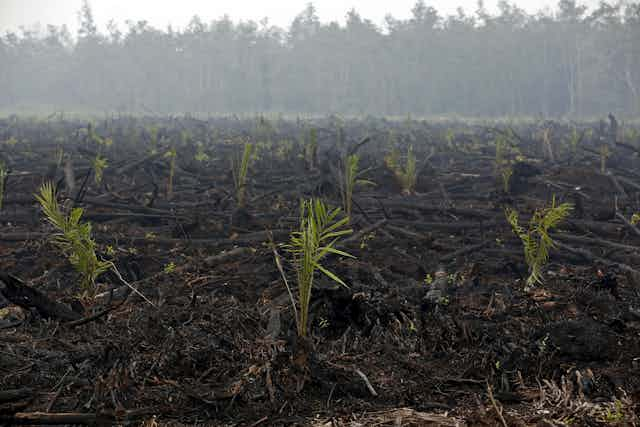At the Paris climate negotiations, Indonesia will bring to the table a target of an unconditional 29% emissions reduction by 2030, increasing to 41% on condition of international assistance.
Indonesia’s emission reduction plan (or Intended Nationally Determined Contribution) is therefore slightly higher than its 2009 commitment to reduce emissions by 26% by 2020.
There are three problems with Indonesia’s INDC. The target is not ambitious; the plan is incoherent; and with the recent massive forest fires in Indonesia that have yet to be accounted for in the INDC it does not accurately reflect emissions for Indonesia.
Such a problematic INDC would affect the global efforts to adequately tackle climate change, since Indonesia is one of the biggest carbon emitters in the world. The forest fires have pushed the country into the top ranks of global greenhouse gas emitters.
Unambitious target
Each countries’ INDCs will determine whether the world can achieve a global target to reduce carbon emissions that can slow down global warming, limiting it to no more than 2°C relative to the pre-industrial era.
Is Indonesia’s target ambitious enough so that when compared with other countries’ INDCs it can achieve this global target? Not really.
For Indonesia to meaningfully contribute to the global target, Indonesia’s emissions should be stable or decrease even when the nation’s economy grows. The latest assessment from Intergovernmental Panel on Climate Change suggests this way of decoupling GDP growth from emissions growth to be ideal. However, Indonesia may find that difficult to do given that its economies depend on high emission sectors such as agriculture, forestry and energy.
At the moment, Indonesia does aim to decouple its GDP growth and emission rate increase, but only through relative decoupling, through which emissions rate increase is expected to be lower than GDP growth.
In relation to the global target as informed by climate science, the 29% emissions reductions target is not ambitious enough. Furthermore, with the depth of Indonesia’s problems, especially with the recent forest fires, Indonesia’s target should be higher.
Incoherent plan
Indonesia’s climate plan is not coherent. There are no proper relations between different actions, sectors and parts of planning process such as between the allocated budget and mitigation actions.
The incoherence is largely due to a problematic process in producing the INDC.
The 29% target was first produced by the Indonesia Development and Planning Board (Bappenas) using scientifically sound calculations. However, Bappenas was not participative in their process. They involved only a very limited circle of agencies and did not consult with regional governments, the private sector and NGOs. Transparency was lacking in the process and modelling.
The advisory board for Indonesia’s ministry of environment and forestry who prepared the country’s INDC used the result of these calculations to produce the INDC document. The advisory board’s process was more participative. They included more stakeholders to take part in their climate plan.
However, they took the number that Bappenas produced - 29% emissions reductions - from its modelling, and stripped the relations, assumptions and data that Bappenas used to come to that number. As a result, the INDC document entails rich inputs but these are not always connected and even contradict each other.
Forest fires
With these problems, Indonesia’s INDC should be revised. With the recent massive forest fires in Indonesia, the INDC should be more honest and include realistic simulations of peat-land management.
Deforestation and land use activities are Indonesia’s largest source of carbon emissions. Indonesia is the top exporter of palm oil. To expand plantations of oil palms, farmers often use the slash-and-burn techniques to open new plantations. With this year’s El Niño, with temperatures rising above the 1997 levels, the fires were some of the worst of recent times. At one point daily emissions in Indonesia surpassed emissions from the entire US economy as a result of the fires.
The fires will become a critical pretext for the Paris negotiations. They may increase the level of ambition of countries to do more. The issue of forest fires may also spur other countries to help more because the scale of the impact was enormous both for Indonesia and the international community.
Indonesia’s position in the negotiations
At the moment Indonesia seems yet to be prepared for the Paris 2015 negotiations. We have yet to see a specific agenda that Indonesia would like to bring to the table.
This is partly due to the recent organisational change after president Joko Widodo took office last year.
Under former president Susilo Bambang Yudhoyono, the focal point for climate change negotiations was the National Council for Climate Change (DNPI). This council often prepared working groups to discuss different negotiation themes, such as financing, transfer of technology, adaptation, and others, ahead of the conference.
Joko Widodo merged the council into the Ministry of Environment and Forestry under a new directorate that oversees climate change. This ministry established the aforementioned Advisory Board.
With the new structure, the new directorate and advisory board did not have enough time to organise working groups that are able to undertake proper preparations. As a result, just days before the negotiation, we have yet to have a so-called Indonesia position for various issues on climate change action.


